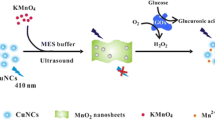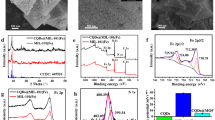Abstract
Highly sensitive detection of H2O2 and glucose is critical for fundamental research and disease diagnosis. A ratiometric sensor can simultaneously afford two readout signals that provide an internally normalized response to change, thereby reducing false results and improving detection accuracy. A novel ratiometric fluorescent nanosensor for ultrasensitive detection of hydrogen peroxide and glucose was constructed on the basis of the peroxidase-like properties of a hierarchical cobalt/carbon nanotube hybrid nanocomplex (Co-CNT). The as-prepared Co-CNT catalyzes the transformation of the non-fluorescent Amplex Red (AR) into a fluorescent derivative and the transformation of fluorescent scopoletin (SC) into a non-fluorescent derivative in the presence of H2O2. The sensing system changes colour from yellow to blue, which can be clearly seen with the naked eye. With the fluorescence ratio of AR to SC as readout, the detection limit of H2O2 reaches as low as 100 nM. The developed assay is further utilized for determining H2O2-related oxidase reactions with the glucose and glucose oxidase system as model. Glucose can be selectively and sensitively detected as low as 150 nM. Satisfactory recoveries are obtained for glucose detection in serum samples. The developed assay is simple in terms of preparation and operation and provides a straightforward method for cost-effective and reliable detection of H2O2 and H2O2-related reactions in clinical diagnosis and biomedical applications.

Graphical abstract






Similar content being viewed by others
References
Liu JW, Luo Y, Wang YM, Duan LY, Jiang JH, Yu RQ. Graphitic carbon nitride nanosheets-based ratiometric fluorescent probe for highly sensitive detection of H2O2 and glucose. ACS Appl Mater Interfaces. 2016;8:33439–45.
Giorgio M, Trinei M, Migliaccio E, Pelicci PG. Hydrogen peroxide: a metabolic by-product or a common mediator of ageing signals? Nat Rev Mol Cell Bio. 2007;8:722–8.
Ju J, Chen W. In situ growth of surfactant-free gold nanoparticles on nitrogen-doped graphene quantum dots for electrochemical detection of hydrogen peroxide in biological environments. Anal Chem. 2015;87:1903–10.
Finkel T, Serrano M, Blasco MA. The common biology of cancer and ageing. Nature. 2007;448:767–74.
Liu B, Sun Z, Huang PJJ, Liu J. Hydrogen peroxide displacing DNA from nanoceria: mechanism and detection of glucose in serum. J Am Chem Soc. 2015;137:1290–5.
Hu X, Yu J, Qian C, Lu Y, Kahkoska AR, Xie Z, et al. H2O2-responsive vesicles integrated with transcutaneous patches for glucose-mediated insulin delivery. ACS Nano. 2017;11:613–20.
Yu J, Qian C, Zhang Y, Cui Z, Zhu Y, Shen Q, et al. Hypoxia and H2O2 dual-sensitive vesicles for enhanced glucose-responsive insulin delivery. Nano Lett. 2017;17:733–9.
Zhang Y, Wang J, Yu J, Wen D, Kahkoska AR, Lu Y, et al. Bioresponsive microneedles with a sheath structure for H2O2 and pH cascade-triggered insulin delivery. Small. 2018;14:1704181.
Zeng HH, Qiu WB, Zhang L, Liang RP, Qiu JD. Lanthanide coordination polymer nanoparticles as an excellent artificial peroxidase for hydrogen peroxide detection. Anal Chem. 2016;88:6342–8.
Feng D, Gu ZY, Li JR, Jiang HL, Wei Z, Zhou HC. Zirconium-metalloporphyrin PCN-222: mesoporous metal-organic frameworks with ultrahigh stability as biomimetic catalysts. Angew Chem Int Ed. 2012;51:10307–10.
Xiong Y, Chen S, Ye F, Su L, Zhang C, Shen S, et al. Synthesis of a mixed valence state Ce-MOF as an oxidase mimetic for the colorimetric detection of biothiols. Chem Commun. 2015;51:4635–8.
Wang Q, Zhang L, Shang C, Zhang Z, Dong S. Triple-enzyme mimetic activity of nickel–palladium hollow nanoparticles and their application in colorimetric biosensing of glucose. Chem Commun. 2016;52:5410–3.
Zhang Y, Xu C, Li B, Li Y. In situ growth of positively-charged gold nanoparticles on single-walled carbon nanotubes as a highly active peroxidase mimetic and its application in biosensing. Biosens Bioelectron. 2013;43:205–10.
Baghayeri M, Amiri A, Farhadi S. Development of non-enzymatic glucose sensor based on efficient loading ag nanoparticles on functionalized carbon nanotubes. Sens Actuator B Chem. 2016;225:354–62.
Fu S, Fan G, Yang L, Li F. Non-enzymatic glucose sensor based on au nanoparticles decorated ternary Ni-Al layered double hydroxide/single-walled carbon nanotubes/graphene nanocomposite. Electrochim Acta. 2015;152:146–54.
Chen Y, Cao H, Shi W, Liu H, Huang Y. Fe–Co bimetallic alloy nanoparticles as a highly active peroxidase mimetic and its application in biosensing. Chem Commun. 2013;49:5013–5.
Lu C, Liu X, Li Y, Yu F, Tang L, Hu Y, et al. Multifunctional Janus hematite–silica nanoparticles: mimicking peroxidase-like activity and sensitive colorimetric detection of glucose. ACS Appl Mater Interfaces. 2015;7:15395–402.
Mei H, Wu W, Yu B, Wu H, Wang S, Xia Q. Nonenzymatic electrochemical sensor based on Fe@Pt core–shell nanoparticles for hydrogen peroxide, glucose and formaldehyde. Sens Actuator B Chem. 2016;223:68–75.
Li M, Liu L, Xiong Y, Liu X, Nsabimana A, Bo X, et al. Bimetallic MCo (M = Cu, Fe, Ni, and Mn) nanoparticles doped-carbon nanofibers synthetized by electrospinning for nonenzymatic glucose detection. Sens Actuator B Chem. 2015;207:614–22.
Xu Y, Chen Y, Yang N, Sun L, Li G. DNA-templated silver nanoclusters formation at gold electrode surface and its application to hydrogen peroxide detection. Chin J Chem. 2012;30:1962–5.
Fan W, Bu W, Shen B, He Q, Cui Z, Liu Y, et al. Intelligent MnO2 nanosheets anchored with upconversion nanoprobes for concurrent pH-/H2O2-responsive UCL imaging and oxygen-elevated synergetic therapy. Adv Mater. 2015;27:4155–61.
Yuan J, Cen Y, Kong XJ, Wu S, Liu CL, Yu RQ, et al. MnO2-nanosheet-modified upconversion nanosystem for sensitive turn-on fluorescence detection of H2O2 and glucose in blood. ACS Appl Mater Interfaces. 2015;7:10548–55.
Zhao H, Dong Y, Jiang P, Wang G, Zhang J. Highly dispersed CeO2 on TiO2 nanotube: a synergistic nanocomposite with superior peroxidase-like activity. ACS Appl Mater Interfaces. 2015;7:6451–61.
Artiglia L, Agnoli S, Paganini MC, Cattelan M, Granozzi G. TiO2@CeOx core–shell nanoparticles as artificial enzymes with peroxidase-like activity. ACS Appl Mater Interfaces. 2014;6:20130–6.
Ma Y, Cen Y, Sohail M, Xu G, Wei F, Shi M, et al. A ratiometric fluorescence universal platform based on N, Cu codoped carbon dots to detect metabolites participating in H2O2-generation reactions. ACS Appl Mater Interfaces. 2017;9:33011–9.
Liu Y, Tu D, Zheng W, Lu L, You W, Zhou S, et al. A strategy for accurate detection of glucose in human serum and whole blood based on an upconversion nanoparticles-polydopamine nanosystem. Nano Res. 2018;11:3164–74.
Lu H, Xu S. Visualizing BPA by molecularly imprinted ratiometric fluorescence sensor based on dual emission nanoparticles. Biosens Bioelectron. 2017;92:147–53.
Liu F, Bing T, Shangguan D, Zhao M, Shao N. Ratiometric fluorescent biosensing of hydrogen peroxide and hydroxyl radical in living cells with lysozyme–silver nanoclusters: lysozyme as stabilizing ligand and fluorescence signal unit. Anal Chem. 2016;88:10631–8.
Xu M, Han JM, Wang C, Yang X, Pei J, Zang L. Fluorescence ratiometric sensor for trace vapor detection of hydrogen peroxide. ACS Appl Mater Interfaces. 2014;6:8708–14.
Lei Y, Xue C, Zhang S, Sha Y. A ratiometric fluorescent probe for sensing hydrogen peroxide based on a hemicyanine–naphthol fluorophore. Luminescence. 2016;31:660–4.
Goggins S, Apsey EA, Mahon MF, Frost CG. Ratiometric electrochemical detection of hydrogen peroxide and glucose. Org Biomol Chem. 2017;15:2459–66.
Hou Y, Li J, Wen Z, Cui S, Yuan C, Chen J. Co3O4 nanoparticles embedded in nitrogen-doped porous carbon dodecahedrons with enhanced electrochemical properties for lithium storage and water splitting. Nano Energy. 2015;12:1–8.
Aijaz A, Masa J, Rösler C, Xia W, Weide P, Botz AJR, et al. Co@Co3O4 encapsulated in carbon nanotube-grafted nitrogen-doped carbon polyhedra as an advanced bifunctional oxygen electrode. Angew Chem Int Ed. 2016;55:4087–91.
Huang ZF, Song J, Li K, Tahir M, Wang YT, Pan L, et al. Hollow cobalt-based bimetallic sulfide polyhedra for efficient all-pH-value electrochemical and photocatalytic hydrogen evolution. J Am Chem Soc. 2016;138:1359–65.
Xia BY, Yan Y, Li N, Wu HB, Lou XWD, Wang X. A metal–organic framework-derived bifunctional oxygen electrocatalyst. Nature Energy. 2016;1:15006.
Ryan TK, Jacky WY, ZhongáTang B. An AIE-active fluorescence turn-on bioprobe mediated by hydrogen-bonding interaction for highly sensitive detection of hydrogen peroxide and glucose. Chem Commun. 2016;52:10076–9.
Wen Y, Liu K, Yang H, Liu Y, Chen L, Liu Z, et al. Mitochondria-directed fluorescent probe for the detection of hydrogen peroxide near mitochondrial DNA. Anal Chem. 2015;87:10579–84.
Chang HC, Ho JAA. Gold nanocluster-assisted fluorescent detection for hydrogen peroxide and cholesterol based on the inner filter effect of gold nanoparticles. Anal Chem. 2015;87:10362–7.
Acknowledgements
This work is supported by the National Natural Science Foundation of China (No. 21575138 and No. 21775108).
Author information
Authors and Affiliations
Corresponding authors
Ethics declarations
Conflict of interest
The authors declare that they have no competing interests.
Additional information
Publisher’s note
Springer Nature remains neutral with regard to jurisdictional claims in published maps and institutional affiliations.
Electronic supplementary material
ESM 1
(PDF 712 kb)
Rights and permissions
About this article
Cite this article
Qian, P., Qin, Y., Lyu, Y. et al. A hierarchical cobalt/carbon nanotube hybrid nanocomplex-based ratiometric fluorescent nanosensor for ultrasensitive detection of hydrogen peroxide and glucose in human serum. Anal Bioanal Chem 411, 1517–1524 (2019). https://doi.org/10.1007/s00216-019-01573-z
Received:
Revised:
Accepted:
Published:
Issue Date:
DOI: https://doi.org/10.1007/s00216-019-01573-z




